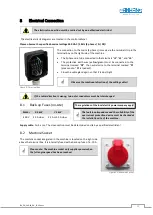
BA_PH_245-20_EN_15-22.docx
18
4.3.3
Special work within the Scope of Maintenance Work as well as Troubleshooting
in the Workflow
Observe maintenance and inspection activities prescribed in the operating manual!
These activities, as well as all other repair work, may only be carried out by qualified personnel!
For all work concerning operation, production adjustment, conversion or setting of the machine and its
safety-related equipment as well as maintenance and repair, observe switch-on and switch-off procedures
according to the operating manual and instructions for maintenance work!
Secure the machine against unexpected restarting during maintenance and repair work.
➔
Lock the main switch with a padlock!
Always tighten screw connections that have been loosened during maintenance and repair work!
If it is necessary to dismantle safety equipment during set-up, maintenance and repair, the safety equip-
ment must be reassembled and checked immediately after completion of the maintenance and repair
work!
Ensure safe and environmentally friendly disposal of operating and auxiliary materials (e.g. oils) and re-
placement parts (e.g. electronic components). See chapter
„D
isassembly and Scraping
“.
4.3.4
After Work
Before leaving the machine, switch off the main switch and the extraction system.
Secure the machine against unauthorised use and never leave it unattended in an unsecured condition.
Clean the machine with an industrial hoover (avoid compressed air!).
4.4
Safe Working Practices
Depending on the work to be carried out, the guards must be used for fence milling, insert milling, curved milling
and also for tenoning. Nevertheless, in order to prevent accidents, it is necessary that the user observes safe
working practices.
4.4.1
Operator Training
It is important that all users of table milling machines are adequately instructed in the use, setting and operation.
This concerns in detail:
Possible hazards that may occur when working with the machine.
The basics of machine operation, correct setting and use of the fences, templates, aids and guards.
The correct selection of the tool for the respective processing.
The safe workpiece guidance and feeding.
The correct hand position and safe stacking and unstacking of the workpieces before and after machining.
4.4.2
Stability
For safe operation of the machine, it is necessary that it is stable and securely fastened to the floor or
another safe part of the building.
4.4.3
Setting up and Adjusting the Machine
Before starting the adjustment, the machine must be disconnected from the mains supply.
For tool clamping, refer to the recommendations of the tool manufacturer.
To ensure safe and effective machining, the tool must be suitable for the material to be machined.
Tools must be sharp and mounted on carefully balanced tool holders.
















































